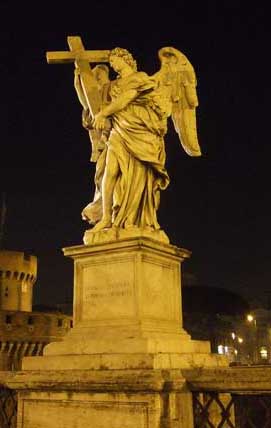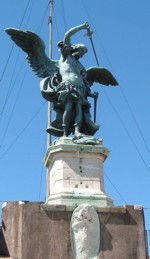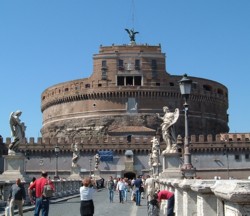For the first-time visitor, Castel Sant’Angelo is one of Rome’s finest sights. It also has a history more varied and interesting than most of the city’s other monuments, and it’s well worth getting to know it better.
The building was originally constructed by the Emperor Hadrian between 123 and 139AD to serve as his mausoleum. Like the earlier Mausoleum of Augustus, the cylindrical tomb would have been topped with statues: a grand reminder of the emperor and his dynasty. Inside you can still walk up the wide spiral passage designed for the ascent of the funeral cortege.
A century and a half later, the tomb was incorporated into the Aurelian Wall, and from then on the defensive importance of the monument saw it undergo many military adaptations.

After spending the Middle Ages passing through the hands of various warring Roman families, the fortress was acquired by the papacy in 1377. Having got their hands on this imposing edifice in such a strategic location, the popes had no intention of letting go. They set to work to make the building into a technically-advanced and impregnable citadel to which they could retreat during times of unrest. A covered passageway (the Passetto del Borgo) still connects Castel Sant’Angelo to the Vatican: this was the popes’ emergency escape route. Unprepared for discomfort even under siege, the pontiffs also developed the internal part of the fortress, fashioning elegant papal apartments – and a strong room with a giant safe for the Vatican’s mountain of loot.

Nowadays visitors can explore the legacy of all three uses of the monument: the funeral passage of Hadrian, the defensive battlements and the beautifully-frescoed interiors. The edifice is confusingly warren-like – in fact, a recent court case exposed how the curator had appropriated some rooms inside the monument to use as a private apartment, apparently undetected.
As well as the glorious frescoes, the papal apartments often house temporary exhibitions. Spend some time wandering to make sure you don’t miss anything – such as the small but prettily-decorated bathroom of Pope Clement VII. There are fine views over Rome from the terraces around the upper level, and even a small cafe where you can sit and admire the panorama. The best views of all are from the large terrace beneath the building’s crowning statue. Tosca threw herself off this terrace in Puccini’s opera.
In the summer there are sometimes special evening events held here, which have in the past included medieval warfare displays and folk music recitals, as well as a bar on the highest terrace.
Castel Sant’Angelo is located on the banks of the Tiber in the heart of Rome. It’s close to the Vatican, and the same bus services serve both destinations (including the 40 express from Stazione Termini). The nearest Metro station is Lepanto (Linea A). Opening hours are 9am-7pm, Tuesday-Sunday. There is an entrance fee.
